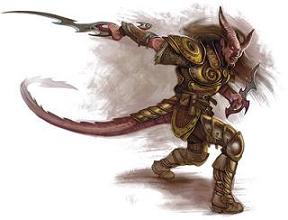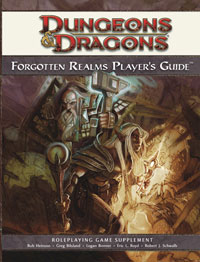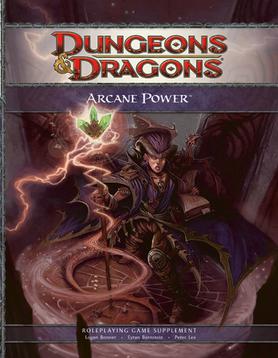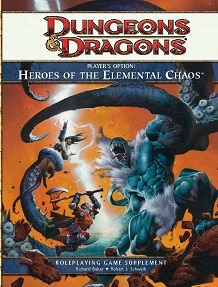
The tiefling is a fictional humanoid race in the Dungeons & Dragons (D&D) fantasy roleplaying game. Originally introduced in the Planescape campaign setting in the second edition of Advanced Dungeons & Dragons as a player character race for the setting, they became one of the primary races available for player characters in the fourth edition of the game.
The magic in Dungeons & Dragons consists of the spells and magic systems used in the settings of the role-playing game Dungeons & Dragons (D&D). D&D defined the genre of fantasy role-playing games, and remains the most popular table-top version. Many of the original concepts have become widely used in the role-playing community across many different fictional worlds, as well as across all manner of popular media including books, board games, video games, and films.
The druid is a playable character class in the Dungeons & Dragons fantasy role-playing game. Druids wield nature-themed magic. Druids cast spells like clerics, but unlike them do not have special powers against undead and, in some editions, cannot use metal armor. Druids have a unique ability that allows them to change into various animal forms, and various other qualities that assist them in natural settings.
Several different editions of the Dungeons & Dragons (D&D) fantasy role-playing game have been produced since 1974. The current publisher of D&D, Wizards of the Coast, produces new materials only for the most current edition of the game. However, many D&D fans continue to play older versions of the game and some third-party companies continue to publish materials compatible with these older editions.

Complete Arcane is a supplemental rulebook for the 3.5 edition of the Dungeons & Dragons role-playing game. It expands upon and replaces an earlier soft-cover rulebook entitled Tome and Blood.
The bard is a standard playable character class in many editions of the Dungeons & Dragons fantasy role-playing game. The bard class is versatile, capable of combat and of magic. Bards use their artistic talents to induce magical effects. The class is loosely based on the special magic that music holds in stories such as the Pied Piper of Hamelin, and in earlier versions was much more akin to being a Celtic Fili or a Norse Skald, although these elements have largely been removed in later editions. Listed inspirations for bards include Taliesin, Homer, Will Scarlet and Alan-a-Dale.
The fighter is one of the standard playable character classes in the Dungeons & Dragons fantasy role-playing game. A fighter is a versatile, weapons-oriented warrior who fights using skill, strategy and tactics.
The Ranger is one of the standard playable character classes in most editions of the Dungeons & Dragons fantasy role-playing game. Rangers are skilled bushcraftsmen/woodcraftsmen, and often lived reclusive lives as hermits.
A character class is a fundamental part of the identity and nature of characters in the Dungeons & Dragons role-playing game. A character's capabilities, strengths, and weaknesses are largely defined by their class; choosing a class is one of the first steps a player takes to create a Dungeons & Dragons player character. A character's class affects a character's available skills and abilities. A well-rounded party of characters requires a variety of abilities offered by the classes found within the game.
The sorcerer is a playable character class in the Dungeons & Dragons fantasy role-playing game. A sorcerer is weak in melee combat, but a master of arcane magic, generally the most powerful form of D&D magic. Sorcerers' magical ability is innate rather than studied or bargained.
The barbarian is a playable character class in the Dungeons & Dragons fantasy role-playing game. The class was introduced in 1985 and went through a number of variations in subsequent editions of the game.
The monk is a playable character class in most editions of the Dungeons & Dragons fantasy role-playing game. A D&D monk is a fantasy martial artist, specializing in unarmed combat.
The wizard is one of the standard character class in the Dungeons & Dragons fantasy role-playing game. A wizard uses arcane magic, and is considered less effective in melee combat than other classes.

Complete Mage is a supplemental rule book for the 3.5 edition of the Dungeons & Dragons role-playing game. It is effectively the sequel to Complete Arcane.

The Forgotten Realms Player's Guide is a supplement to the 4th edition of the Dungeons & Dragons role-playing game.

Dark Sun is an original Dungeons & Dragons (D&D) campaign setting set in the fictional, post-apocalyptic desert world of Athas. Dark Sun featured an innovative metaplot, influential art work, dark themes, and a genre-bending take on traditional fantasy role-playing. The product line began with the original Dark Sun Boxed Set released for D&D's 2nd edition in 1991, originally ran until 1996, and was one of TSR's most successful releases.
The artificer is a playable character class in the Dungeons & Dragons (D&D) fantasy role-playing game. The Artificer first appeared as a full class in the 3.5 edition of D&D and was introduced in the Eberron campaign setting. The artificer is a unique base class that reflects many of the core themes of Eberron.

Arcane Power is a supplement for the 4th edition of the Dungeons & Dragons fantasy role-playing game.

Heroes of Forgotten Kingdoms is a supplement to the 4th edition of the Dungeons & Dragons role-playing game.

Heroes of the Elemental Chaos is a supplement to the 4th edition of the Dungeons & Dragons role-playing game. This book is one of three source books, along with Manual of the Planes (2008) and The Plane Below: Secrets of the Elemental Chaos (2009), from this era that details the Elemental Chaos from the 4th edition World Axis cosmology.






